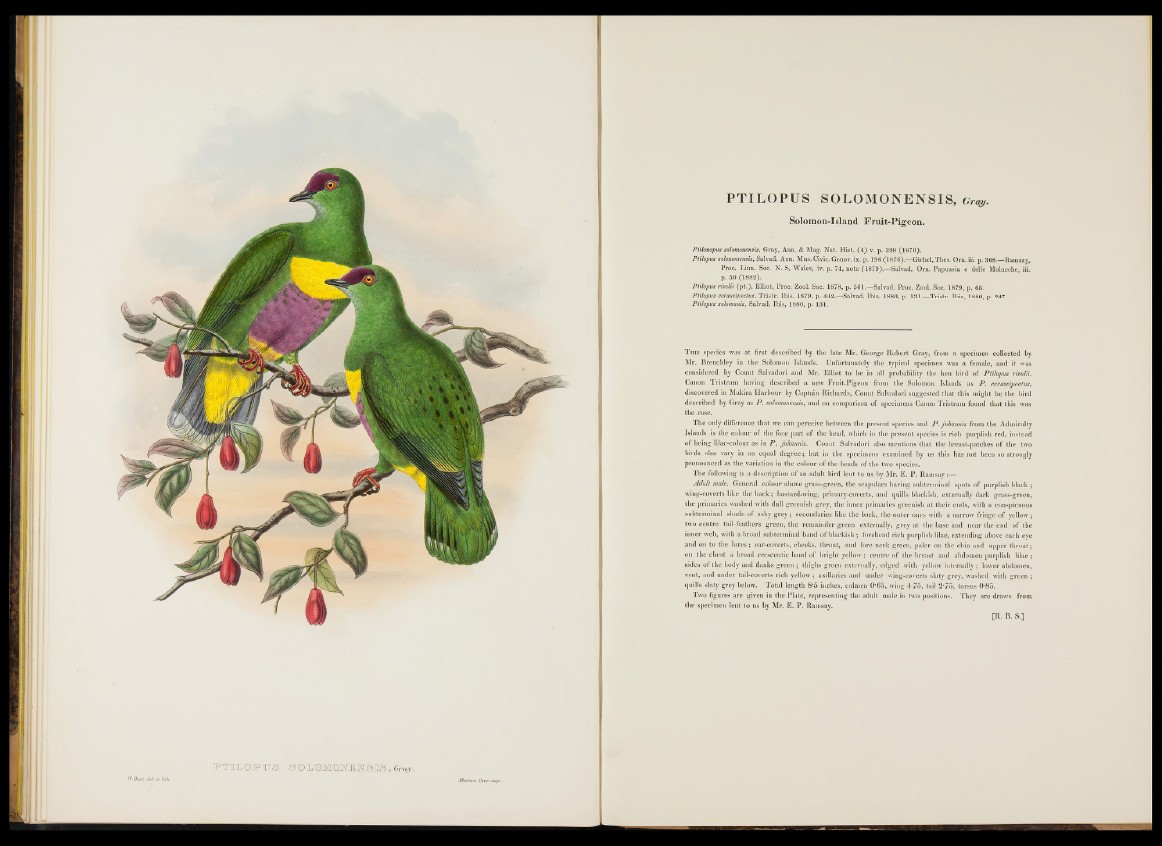
F T IILO FU S S03L©M(D)M]EMIS9Gray.
PTILOPUS SOLOMONENSIS, Gray.
Solomon-Island Fruit-Pigeon.
Ptilonopus solomonensis, Gray, Ann. & Mag. Nat. Hist. (4 ) v. p. 328 (1870).
Ptilopus solomonensis, Salvad. Ann. Mus. Civic. Genov, ix. p. 196 (1876).—Giebel, Thes. Orn. iii. p. 368.—Ramsay,
Proc. Linn. Soc. N. S. Wales, iv. p. 74, note (1879).—Salvad. Orn. Papuasia e delle Molucche, iii.
p. 50 (1882).
Ptilopus rivolii (p t.), Elliot, Proc. Zool. Soc. 1878, p. 561.—Salvad. Proc. Zool. Soc. 1879, p. 65.
Ptilopus ceraseipectus, Tristr. Ibis, 1879, p. 442.—Salvad. Ibis, 1880, p. 131.—Tristr. Ibis, 1880, p. 247.
Ptilopus salomonis, Salvad. Ibis, 1880, p. 131.
T h is species was at first described by the late Mr. George Robert Gray, from a specimen collected by
Mr. Brenchley in the Solomon Islands. Unfortunately the typical specimen was a female, and it was
considered by Count Salvadori and Mr. Elliot to be in all probability the hen bird o f Ptilopus rivolii.
Canon Tristram having described a new Fruit-Pigeon from the Solomon Islands as P . ceraseipectus,
discovered in Makira Harbour by Captain Richards, Count Salvadori suggested that this might be the bird
described by Gray as P. solomonensis, and on comparison o f specimens Canon Tristram found th at this was
the case.
The only difference th at we can perceive between the present species and P.johannis from the Admiralty
Islands is the colour o f the fore p a rt o f the head, which in the present species is rich purplish red, instead
o f being lilac-colour as in P. johannis. Count Salvadori also mentions th at the breast-patches o f the two
birds also vary in an equal d e g re e ; but in the specimens examined by us this has not been so strongly
pronounced as the variation in the colour o f the heads o f the two species.
The following is a description o f an adult bird lent to us by Mr. E. P. Ramsay
Adult male. General colour above grass-green, the scapulars having subterminal spots o f purplish black ;
wing-coverts like the back ; bastard-wiug, primary-coverts, and quills blackish, externally dark grass-green,
the primaries washed with dull greenish grey, the inner primaries greenish a t their ends, with a conspicuous
subterminal shade o f ashy grey ; secondaries like the back, the outer ones with a narrow fringe o f yellow ;
two centre tail-feathers green, the remainder green externally, grey at the base and near the end of the
inner web, with a broad subterminal baud o f blackish ; forehead rich purplish lilac, extending above each eye
and on to the lo res; ear-coverts, cheeks, throat, and fore neck green, paler on the chin and upper th ro a t;
on the chest a broad crescentic band o f bright yellow; centre o f the breast and abdomen purplish lila c ;
sides o f the body and flanks green ; thighs green externally, edged with yellow internally ; lower abdomen,
vent, and under tail-coverts rich yellow; axillaries and under wing-coverts slaty grey, washed with green ;
quills slaty grey below. Total length 8*5 inches, culmen 0*65, wing 4 75, tail 2 -75, tarsus 0 -85.
Two figures a re given in the Plate, representing the adult male in two positions. They are drawn from
the specimen lent to us by Mr. E . P. Ramsay.
[R. B. S.]